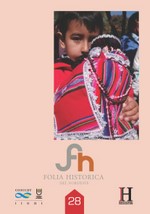¡Qué viva la mamita!: territorialidad(es), espesor(es) temporal(es) y resistencias en las prácticas de un grupo de devotos del culto a urkupiña en la ciudad de Salta-Argentina
DOI:
https://doi.org/10.30972/fhn.0281776Palavras-chave:
Territorialidades, espesores temporales, resistencias, heterogeneidad culturalResumo
La indagación se centra en el estudio de caso de un grupo de familias que se adjudican ser los dueños de una de las imágenes de la Virgen de Urkupiña más longevas de la ciudad de Salta- Argentina. La advocación mariana de origen boliviano se celebra, en el caso analizado, con novenas, procesiones y una fiesta lejos de los rituales que oficia la Iglesia Católica local para el culto en un doble sentido: por un lado, territorialmente y, por el otro, en cuanto a las modalidades de festejo. El trabajo parte de los estudios en comunicación/cultura en diálogo con aportes de la sociología y la antropología de las creencias para pensar que la experiencia analizada teje complejos procesos de territorialidad y de identificación, los cuales se construyen mediante negociaciones/apropiaciones de prácticas devocionarias de diversa procedencia cultural -como la andina en general, la boliviana y la salteña, en particular-donde el espesor temporal de las prácticas posibilita pensar la heterogeneidad cultural. La indagación pretende comprender el pasaje que se produce en un culto migrante que es apropiado/disputado en el Noroeste Argentino
Downloads
Publicado
Edição
Seção
Licença
Se deberá adjuntar una carta, en la que se declare que "el artículo titulado XXX”, es un trabajo original, que no ha sido ni total ni parcialmente publicado en ningún medio impreso o electrónico, que no ha sido remitido simultáneamente a otra publicación y que no se encuentra actualmente en proceso de evaluación en otra publicación. En el caso que sea aceptado para su publicación, transferimos los derechos de publicación a la revista Folia Histórica del Nordeste, quien asume los derechos para editar, publicar, reproducir, distribuir copias, electrónicas o multimedia e incluir el artículo en índices nacionales e internacionales o bases de datos. Por otra parte, dejamos constancia que las afirmaciones vertidas en el mismo son de exclusiva responsabilidad de las/los autoras/es". La carta deberá estar firmada por al menos uno de los autores.






